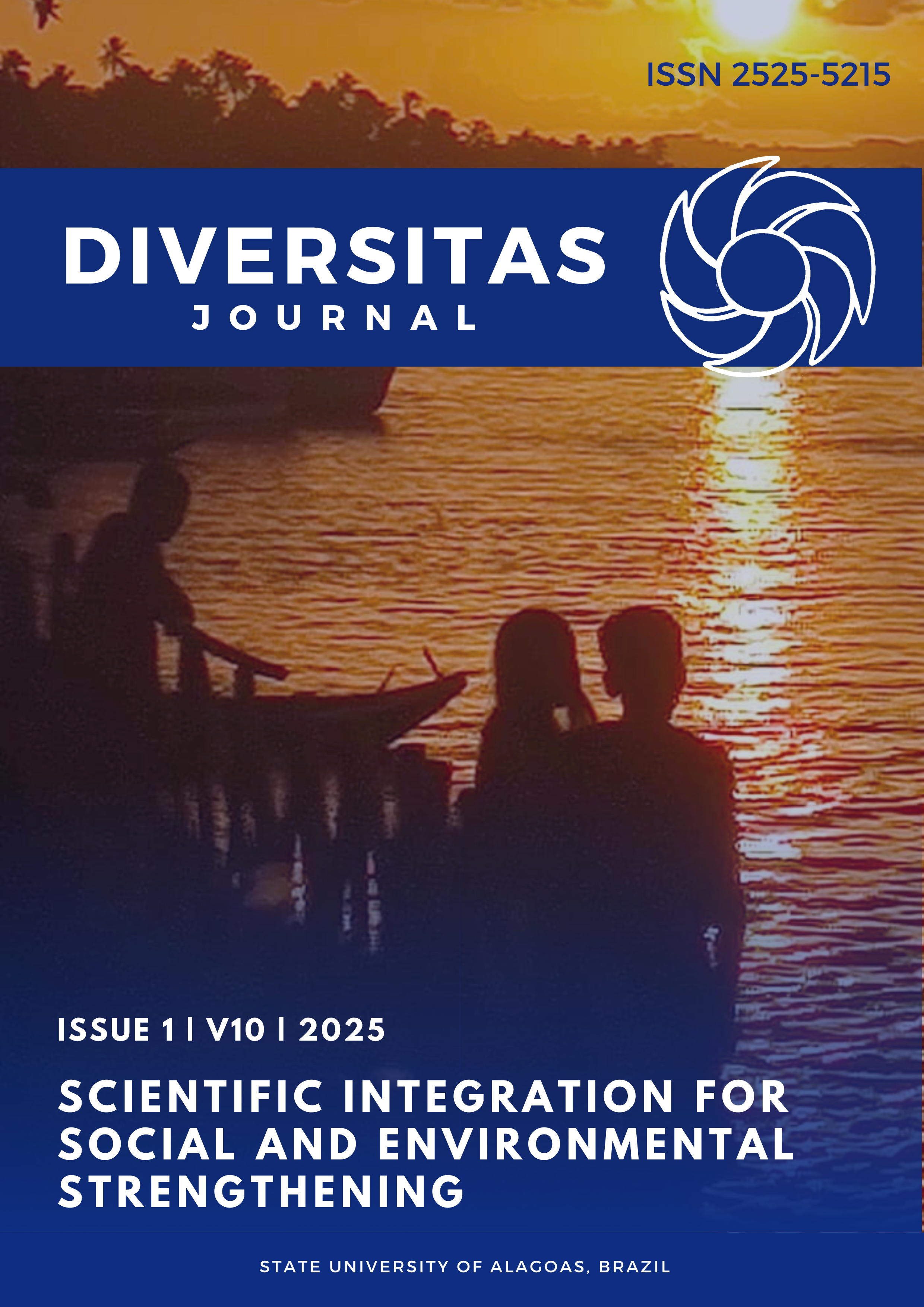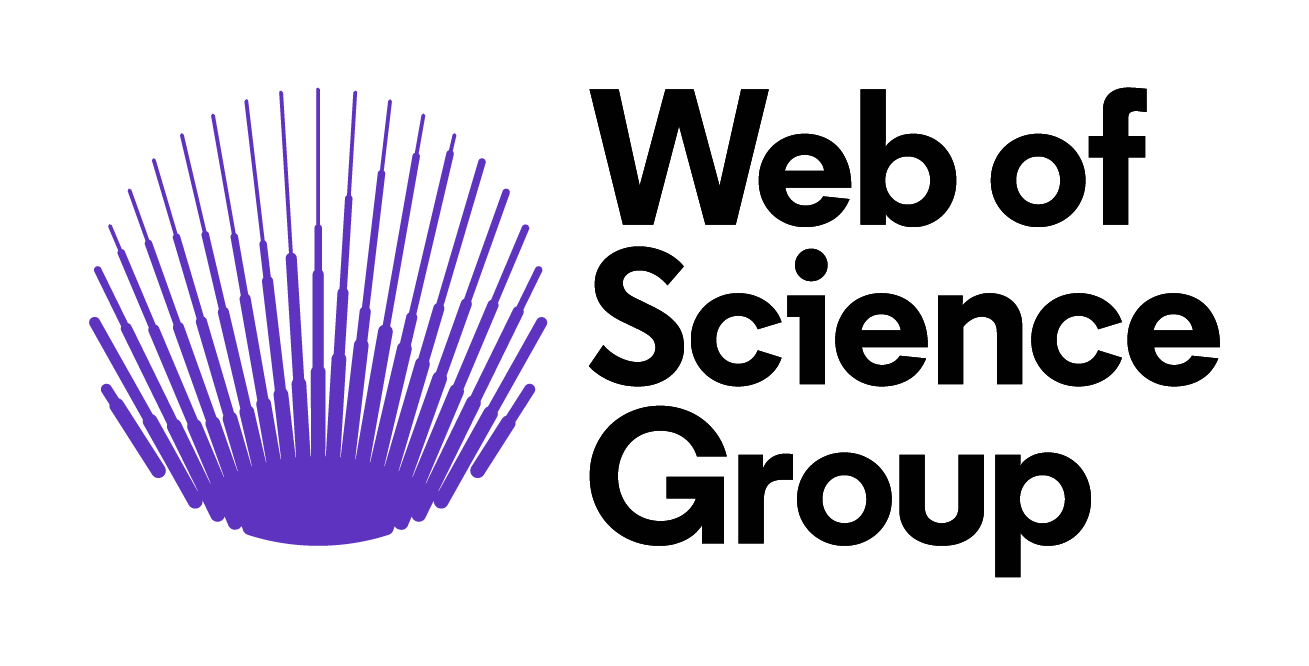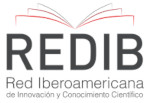Occurrence of florivory in edge species in an Atlantic Forest fragment
DOI:
https://doi.org/10.48017/dj.v10i1.2654Keywords:
Floral antagonism, Floral attractiveness, Floral herbivoryAbstract
The relationship between flowers and floral visitors can be mutualistic or antagonistic. Florivory is defined as floral damage to reproductive and/or sterile attributes. Some studies claim that floral attractants for pollinators also attract florivores. Therefore, the objective of this study is to analyze the occurrence of florivory in species from the edge of the Atlantic Forest, identifying the possible floral attributes associated with the attractiveness to florivores. Seven species were analyzed: Tridax procumbens, Sphagneticola trilobata, Turnera subulata, Richardia grandiflora, Momordica charantia, Chrysanthellum and Commelina erecta. Through direct observation, information was collected on floral attributes: color, shape, resource, symmetry and pollination unit. Visits were made to record the number of damaged flowers. All damaged flowers were photographed and the images submitted to the ImageJ program to calculate the consumed floral area. Flowers with inflorescences arranged in capitulum, yellow placement and UV reflection were more attractive to florivores. There was a weak correlation between the size of the flowers and the damaged floral area, in addition to a weak correlation between the number of flowers in the patches and the number of flowers damaged by the florivores. These data demonstrate the inefficiency of the display effect in reducing florivory and evidence that other traits besides floral size are attracting herbivores to the studied species.
Metrics
References
(CNUC). Cadastro nacional de Unidades de Conservação. Departamento de Áreas Protegidas. https://antigo.mma.gov.br/areas-protegidas/cadastro-nacional-de-ucs.html
Araújo, A. C. D., Gadelha Neto, P. D. C., Quirino, Z. G. M., & Araújo, J. D. L. O. (2009). Síndromes de polinização ocorrentes em uma área de Mata Atlântica, Paraíba, Brasil. https://repositorio.ufrn.br/handle/1/3119
Bagchi, R., Gallery, R. E., Gripenberg, S., Gurr, S. J., Narayan, L., Addis, C. E., ... & Lewis, O. T. (2014). Pathogens and insect herbivores drive rainforest plant diversity and composition. Nature, 506 (7486), 85-88. https://doi.org/10.1038/nature12911
Barbosa, V. S. (2009). Influência da herbivoria de formigas cortadeiras no sucesso reprodutivo de espécies arbustivo-arbóreas da Floresta Atlântica Nordestina [Tese de doutorado, Universidade Federal de Pernambuco]. https://repositorio.ufpe.br/bitstream/123456789/524/1/arquivo4339_1.pdf
Barreto, A. D. A., & Freitas, L. (2007). Atributos florais em um sistema de polinização especializado: Calathea cylindrica (Roscoe) K. Schum. (Marantaceae) e abelhas Euglossini. Brazilian Journal of Botany, 30 (3), 421-431. https://doi.org/10.1590/S0100-84042007000300008
Carper, A. L., Adler, L. S., & Irwin, R. E. (2016). Effects of florivory on plant‐pollinator interactions: Implications for male and female components of plant reproduction. American Journal of botany, 103(6), 1061-1070. https://doi.org/10.3732/ajb.1600144
Costa, K., Santos, B. Y., de Almeida, N. M., Santos, A. M. M., Buril, M. T., & Leite, A. V. (2022). The effects of florivory on floral attractiveness and fruit production in Daustinia montana (Convolvulaceae). Flora, 294, 152122. https://doi.org/10.1016/j.flora.2022.152122
Cotarelli, V. M., & De Almeida, A. N. M. (2015). Florivoria em Senna macranthera var. pudibunda (Benth.) HS Irwin & Barneby (Caesalpinioideae-Fabaceae). NatLine, 13 (1), 45-49. http://www.naturezaonline.com.br/natureza/conteudo/pdf/07_Cotarelli&Almeida_45-49.pdf
Cotarelli, V. M., & Vieira, A. O. S. (2009). Herbivoria floral em Chamaecrista trachycarpa (Vog.) HS Irwin & Barneby, em uma área de campo natural (Telêmaco Borba, Pr, Brasil). Semina: Ciências Biológicas e da Saúde, 30 (1), 91-98. https://www.researchgate.net/profile/Ana-Vieira-11/publication/47658674_Floral_herbivory_in_Chamaecrista_trachycarpa_Vog_HS_Irwin_Barneby_in_an_area_of_campo_natural_Telemaco_Borba_Pr_Brazil_Herbivoria_floral_em_Chamaecrista_trachycarpa_Vog_HS_Irwin_Barneby_em_uma_area_de/links/56965e8608ae1c427903c04f/Floral-herbivory-in-Chamaecrista-trachycarpa-Vog-HS-Irwin-Barneby-in-an-area-of-campo-natural-Telemaco-Borba-Pr-Brazil-Herbivoria-floral-em-Chamaecrista-trachycarpa-Vog-HS-Irwin-Barneby-em-uma.pdf
Cunningham, S. A. (1995). Ecological constraints on fruit initiation by Calyptrogyne ghiesbreghtiana (Arecaceae): floral herbivory, pollen availability, and visitation by pollinating bats. American Journal of Botany, 82(12), 1527-1536. https://doi.org/10.1002/j.1537-2197.1995.tb13855.x
Dantas, M., Almeida, N. V., dos Santos Medeiros, I., & da Silva, M. D. (2017). Diagnóstico da vegetação remanescente de Mata Atlântica e ecossistemas associados em espaços urbanos. Journal of Environmental Analysis and Progress, 2 (1), 87-97. https://doi.org/10.24221/jeap.2.1.2017.1128.87-97
Dáttilo, W., da Costa Marques, E., de Faria Falcão, J. C., & de Oliveira Moreira, D. D. (2009). Interações mutualísticas entre formigas e plantas. EntomoBrasilis, 2(2), 32-36. https://doi.org/10.12741/ebrasilis.v2i2.44
Del-Claro, K., & Torezan-Silingardi, H. M. (2009). Insect-plant interactions: new pathways to a better comprehension of ecological communities in Neotropical savannas. Neotropical Entomology, 38, 159-164. https://www.scielo.br/j/ne/a/VTbxSt7yNNJFcmtMQHZfDrQ/?format=pdf&lang=en
Faegri, K., & Van Der Pijl, L. (2013). Principles of pollination ecology. Pergamon Press.
Fernandes, G. W., Fagundes, M., Greco, M. K. B., Barbeitos, M. S., & Santos, J. C. (2005). Ants and their effects on an insect herbivore community associated with the inflorescences of Byrsonima crassifolia (Linnaeus) HBK (Malpighiaceae). Revista Brasileira de Entomologia, 49 (2), 264-269. https://doi.org/10.1590/S0085-56262005000200011
Ferreira, C. A. (2013). Polinização e herbivoria floral no gênero Banisteriopsis (Malpighiaceae) em área de cerrado de Uberlândia, MG [Dissertação de mestrado, Universidade Federal de Uberlândia]. https://doi.org/10.14393/ufu.di.2013.77
Gonçalves, E. G., & Lorenzi, H. J. (2007). Morfologia vegetal: organografia e dicionário ilustrado de morfologia das plantas vasculares (p. 416p). São Paulo: Instituto Plantarum de estudos da flora.
Gorden, N. L., & Adler, L. S. (2016). Florivory shapes both leaf and floral interactions. Ecosphere, 7 (6), e01326. https://doi.org/10.1002/ecs2.1326
Gorden, N. L., & Adler, L. S. (2018). Consequences of multiple flower–insect interactions for subsequent plant–insect interactions and plant reproduction. American Journal of Botany, 105 (11), 1835-1846. https://doi.org/10.1002/ajb2.1182
Grimaldi, D. (1999). The co-radiations of pollinating insects and angiosperms in the Cretaceous. Annals of the Missouri Botanical Garden, 86 (2), 373-406. https://doi.org/10.2307/2666181
Haigh, M. J. (1980). Ruderal communities in English cities. Urban Ecology, 4(4), 329-338. https://doi.org/10.1016/0304-4009(80)90004-2
Knauer, A. C., Bakhtiari, M., & Schiestl, F. P. (2018). Crab spiders impact floral-signal evolution indirectly through removal of florivores. Nature communications, 9(1), 1367. https://doi.org/10.1038/s41467-018-03792-x
Krupnick, G. A., & Weis, A. E. (1999). The effect of floral herbivory on male and female reproductive success in Isomeris arborea. Ecology, 80(1), 135-149. https://doi.org/10.1890/0012-9658(1999)080[0135:TEOFHO]2.0.CO;2
Lim, G. S., & Raguso, R. A. (2017). Floral visitation, pollen removal, and pollen transport of Tacca cristata Jack (Dioscoreaceae) by female ceratopogonid midges (Diptera: Ceratopogonidae). International Journal of Plant Sciences, 178(5), 341-351. https://doi.org/10.1086/691696
Lima, M. G. C., & Corrêa, A. C. B. (2008). Apropriação de uma unidade de conservação de mata atlântica no espaço urbano de Recife–PE: o caso da reserva de Dois Irmãos. Revista de Geografia (Recife), 22(1), 67-77. https://periodicos.ufpe.br/revistas/revistageografia/article/download/228638/23061
Malo, J. E., Leirana-Alcocer, J., & Parra-Tabla, V. (2001). Population Fragmentation, Florivory, and the Effects of Flower Morphology Alterations on the Pollination Success of Myrmecophila tibicinis (Orchidaceae), 33(3), 529-534. https://doi.org/10.1646/0006-3606(2001)033[0529:PFFATE]2.0.CO;2
Marquis, R. J. (2012). Uma abordagem geral das defesas das plantas contra a ação dos herbívoros. In: Ecologia das interações plantas-animais: uma abordagem ecológica-evolutiva. Technical Books, 55-66.
McCall, A. C. (2008). Florivory affects pollinator visitation and female fitness in Nemophila menziesii. Oecologia, 155(4), 729-737. https://doi.org/10.1007/s00442-007-0934-5
McCall, A. C., & Irwin, R. E. (2006). Florivory: the intersection of pollination and herbivory. Ecology letters, 9(12), 1351-1365. https://doi.org/10.1111/j.1461-0248.2006.00975.x
Mello, M. O., & Silva-Filho, M. C. (2002). Plant-insect interactions: an evolutionary arms race between two distinct defense mechanisms. Brazilian Journal of Plant Physiology, 14, 71-81. https://doi.org/10.1590/S1677-04202002000200001
Oliveira, A. C. S., Souza, J. T., de Brito, V. L. G., & Almeida, N. M. (2021). Attraction of florivores and larcenists and interaction between antagonists in Senna rugosa (Fabaceae). Arthropod-Plant Interactions, 15(4), 535-544. https://doi.org./10.1007/s11829-021-09843-3
Opitz, S. E., & Müller, C. (2009). Plant chemistry and insect sequestration. Chemoecology, 19, 117-154. https://doi.org./10.1007/s00049-009-0018-6
Orozco-Ibarrola, O. A., Flores-Hernández, P. S., Victoriano-Romero, E., Corona-López, A. M., & Flores-Palacios, A. (2015). Are breeding system and florivory associated with the abundance of Tillandsia species (Bromeliaceae)?. Botanical Journal of the Linnean Society, 177(1), 50-65. https://doi.org/10.1111/boj.12225
Palacios-Mosquera, Y., Mondragón, D., & Santos-Moreno, A. (2018). Florivores vertebrados de epífitas vasculares: o caso de uma bromélia. Brazilian Journal of Biology, 79, 201-207. https://doi.org/10.1590/1519-6984.176023
Penet, L., Collin, C. L., & Ashman, T. L. (2009). Florivory increases selfing: an experimental study in the wild strawberry, Fragaria virginiana. Plant Biology, 11(1), 38-45. https://doi.org/10.1111/j.1438-8677.2008.00141.x
Ramirez, N., Gil, C., Hokche, O., Seres, A., & Brito, Y. (1990). Biologia floral de una comunidad arbustiva tropical en la Guayana Venezolana. Annals of the Missouri Botanical Garden, 77 (2) 383-397. https://doi.org/10.2307/2399554
Rasband, Wayne S. (1997). ImageJ. US national institutes of health.
Rech, A. R., Agostini, K., Oliveira, P. E., & Machado, I. C. (Eds.). (2014). Biologia da polinização (p. 524). Projecto Cultural.
Ribeiro, F. (2009). Efeito da herbivoria por saúvas sobre a fenologia, sobrevivência, crescimento e conteúdo nutricional de árvores do Cerrado [Dissertação de mestrado, Universidade Federal de Uberlândia]. https://repositorio.ufu.br/handle/123456789/13303
Ribeiro, S. P., Pimenta, H. R., & Fernandes, G. W. (1994). Herbivory by chewing and sucking insects on Tabebuia ochracea. Biotropica, 26 (3), 302-307. https://doi.org/10.2307/2388851
Schiestl, F. P., & Johnson, S. D. (2013). Pollinator-mediated evolution of floral signals. Trends in ecology & evolution, 28(5), 307-315. https://doi.org/10.1016/j.tree.2013.01.019
Scogin, R., Young, D. A., & Jones Jr, C. E. (1977). Anthochlor pigments and pollination biology. II. The ultraviolet floral pattern of Coreopsis gigantea (Asteraceae). Bulletin of the Torrey Botanical Club, 155-159. https://doi.org/10.2307/2484361
Southgate, B. J. (1979). Biology of the Bruchidae. Annual review of entomology, 24(1), 449-473. https://doi.org/10.1146/annurev.en.24.010179.002313
Tsuji, K., & Ohgushi, T. (2018). Florivory indirectly decreases the plant reproductive output through changes in pollinator attraction. Ecology and Evolution, 8(5), 2993-3001. https://doi.org/10.1002/ece3.3921
Tunes, P. (2017). Influência da florivoria sobre a polinização de espécies ornitófilas. [Dissertação de mestrado, Universidade Estadual Paulista Júlio de Mesquita Filho]. https://repositorio.unesp.br/handle/11449/149921
Vallejo, L. R. (2002). Unidade de conservação: uma discussão teórica à luz dos conceitos de território e políticas públicas. Geographia, 4(8), 57-78. https://doi.org/10.22409/GEOgraphia2002.v4i8.a13433
Van Der Kooi, C. J., & Ollerton, J. (2020). The origins of flowering plants and pollinators. Science, 368(6497), 1306-1308. https://doi.org/10.1126/science.aay3662
Vega-Polanco, M., Rodríguez-Islas, L. A., Escalona-Domenech, R. Y., Cruz-López, L., Rojas, J. C., & Solís-Montero, L. (2020). Does florivory affect the attraction of floral visitors to buzz-pollinated Solanum rostratum?. Arthropod-plant interactions, 14, 41-56. https://doi.org/10.1007/s11829-019-09723-x
Weberling, F. (1992). Morphology of flowers and inflorescences. CUP Archive.
Zaú, A. S. (1998). Fragmentação da Mata Atlântica: aspectos teóricos. Floresta e ambiente, 5 (1), 160-170. https://www.academia.edu/download/11534626/Fragmentacao%20Mata%20Atlantica%20Floresta%20e%20Ambiente.pdf
Downloads
Published
How to Cite
Issue
Section
License
Copyright (c) 2025 Agrícia Gabriella Estevam Barros Correia Vasques, Ranuzia Gabriela Lúcia Amaral Prazeres, Karine de Matos Costa, Ana Virgínia Leite

This work is licensed under a Creative Commons Attribution 4.0 International License.
The Diversitas Journal expresses that the articles are the sole responsibility of the Authors, who are familiar with Brazilian and international legislation.
Articles are peer-reviewed and care should be taken to warn of the possible incidence of plagiarism. However, plagiarism is an indisputable action by the authors.
The violation of copyright is a crime, provided for in article 184 of the Brazilian Penal Code: “Art. 184 Violating copyright and related rights: Penalty - detention, from 3 (three) months to 1 (one) year, or fine. § 1 If the violation consists of total or partial reproduction, for the purpose of direct or indirect profit, by any means or process, of intellectual work, interpretation, performance or phonogram, without the express authorization of the author, the performer, the producer , as the case may be, or whoever represents them: Penalty - imprisonment, from 2 (two) to 4 (four) years, and a fine. ”


















